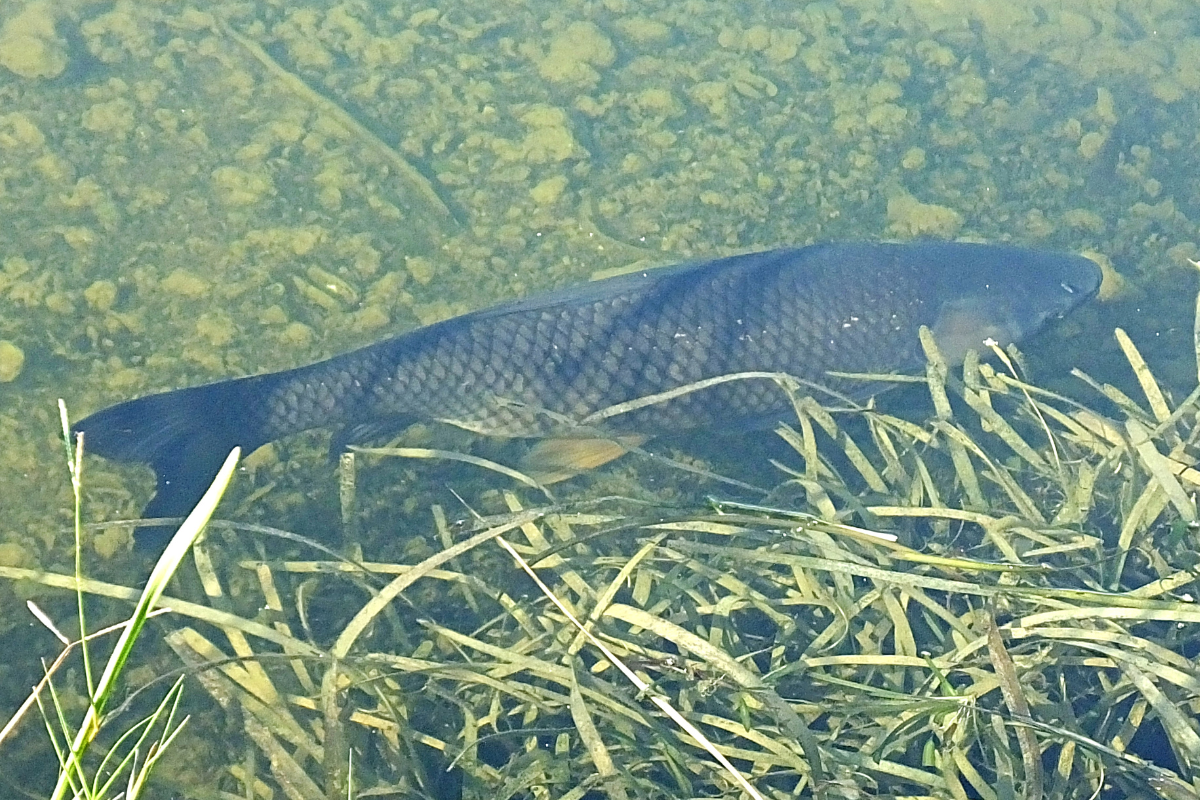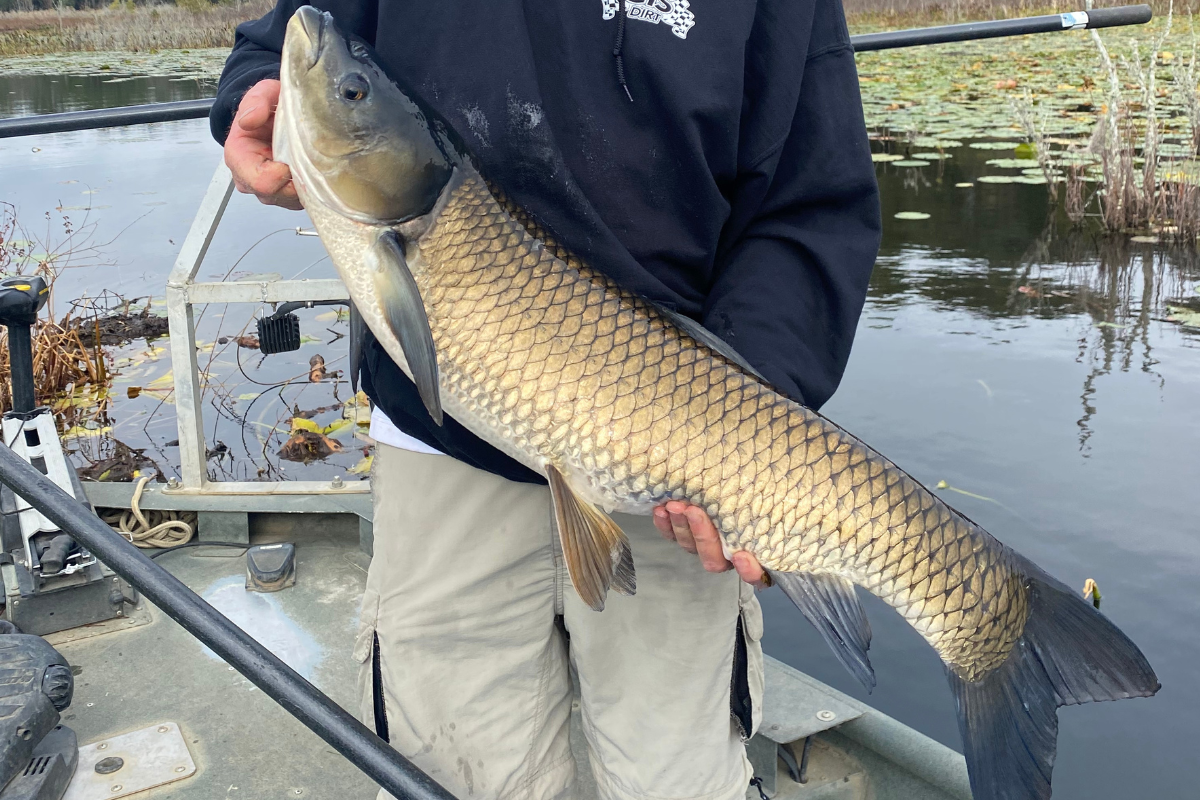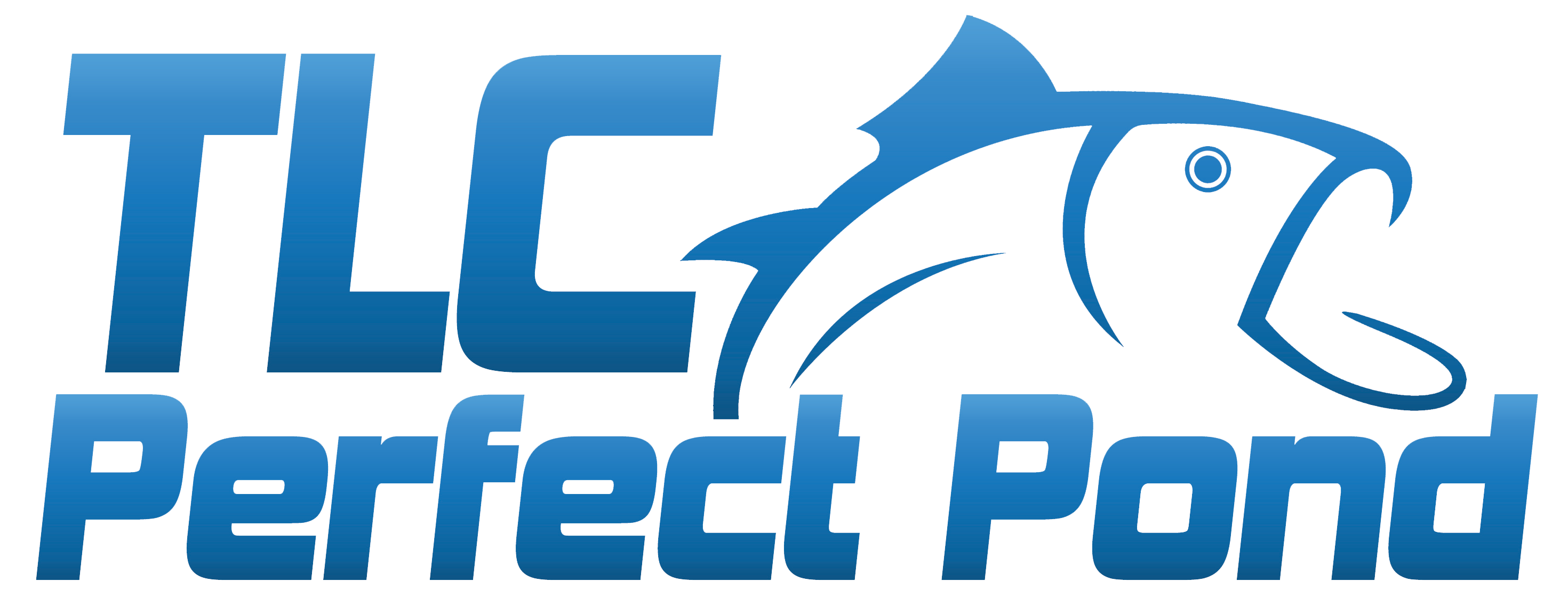Triploid Grass Carp
Stocking triploid grass (Ctenopharyngodon idella) in ponds is a popular strategy for controlling excessive pond vegetation, but there are some things you should know before adding these herbivores to your pond. While these fish can be a cost-effective strategy for managing pond weeds, they do require management over the long term. They are not a one-size-fits-all solution for every pond weed problem, and should be stocked with caution.
Grass carp originate from Asia where they used for human consumption. Some have been noted to live as long as 20 years and reach a maximum size of 4 ft long and 80 lbs. The triploid grass carp, which are commonly used for pond vegetation management, are sterile and cannot reproduce.
Below we’ll discuss some important points to consider before stocking triploid grass carp in your pond. Additionally, you should always check with the regulations for your state. Some jurisdictions prohibit grass carp stocking, especially if your pond is connected to other waterways. Other jurisdictions will require a permit to stock these fish.

What Do Triploid Grass Carp Eat?
The most common misconception with triploid grass carp is that they will consume all types of pond vegetation. There are species of pond vegetation that they will minimally consume and others that they won’t eat at all. Prior to stocking triploid grass carp, you should identify the species of aquatic vegetation that you have.
Grass carp generally prefer softer vegetation that’s below the water surface. They won’t eat hard-stemmed aquatic plants or vegetation that sits on the water surface. The North Carolina Cooperative Extension has published a helpful chart to show the species of aquatic plants that are most likely to be eaten by triploid grass carp.
Aquatic vegetation species that are readily consumed by grass carp include naiad, fanwort, hydrilla, coontail, bladderwort, parrotfeather, elodea, and muskgrass (Chara). Species that are marginally eaten by include duckweed, pennywort, mosquitofern, and common aquatic grasses. Species that are not usually eaten by grass carp include cattail, smartweed, spikerush, torpedograss, alligatorweed, filamentous algae, and watershield.
Triploid grass carp should only be stocked to control an overabundance of one of the readily-consumed aquatic vegetation species above. If you don’t follow these guidelines, it could have serious ecological impacts on your pond. If improperly stocked, they will consume all the desired vegetation in your pond and leave all the unwanted vegetation.

Recommended Stocking Times and Densities
In addition to making sure you have the vegetation that triploid grass carp will eat, there are many other considerations that should be taken before stocking these fish. Grass carp should be stocked during the cooler months of the year, ideally in fall or spring. If you stock them in the heat of summer, you’ll typically see a pretty high mortality rate. This can cause your stocking efforts to get quite expensive as these fish typically aren’t cheap.
Secondly, proper stocking density is very important with triploid grass carp. If you overstock these fish, they can easily deplete all the vegetation in your pond. As we’ve mentioned on a previous blog, 20% or less aquatic vegetation coverage is a good thing. Having some aquatic vegetation will provide cover for prey species and also provide ambush habitat for predator species like largemouth bass.
The Virginia DWR provides stocking density recommendations based on the level of aquatic vegetation coverage. For minor aquatic weed infestations that cover less than 30% of the pond, they recommend stocking 2 fish per acre. For moderate weed infestations covering 30-60% of the pond, they recommend stocking 5 fish per acre. And for heavy infestations covering more than 60% of the pond, they recommend stocking 10 fish per acre.
In addition to the stocking density, the size of fish you stock will be important as well. Larger grass carp will be more costly to stock, but are sometimes the better option depending on the existing fish populations in your pond. If you have a new or recently drained pond with no predator (largemouth bass) populations, you can stock 8″ fish or smaller. Just know that it might take a couple years for them to reach a size where they start eating a significant amount of vegetation. If you have an existing bass population, we recommend stocking 12″ or larger grass carp so the bass don’t eat them.
How to Manage Triploid Grass Carp
As mentioned above, grass carp do require some population management over time. Much like you have to manage your predator and prey populations and keep them in balance, you also have to manage your herbivore populations. If you notice that the amount of vegetation in your pond is quickly being reduced to nothing, you might consider removing some of the carp in the pond. If you notice that the carp are not putting a dent in the vegetation problem, you might consider adding more.
Triploid grass carp will also tend to become less effective as they get older. They tend to get lazy as they age and grow larger. This is especially the case if you have a fish feeder that is used to feed prey and small predator fish. Larger grass carp can become dependent on the fish feeder and will stop eating the pond vegetation. If you see grass carp eating your fish food, it’s probably time to remove them.
Grass carp removal can be tough using traditional angling methods, as they’re not the easiest fish to catch. The most effective way to remove them is by shooting them when you see them feeding at the surface, or through an electrofishing survey. We frequently remove large grass carp when performing population surveys. These big fish are just occupying space in your pond and should be replaced. Remove them and restock with smaller grass carp that will eat the problematic aquatic vegetation.
Triploid grass carp can be a very effective method for controlling excessive pond weeds. They are often cheaper than mechanical or chemical vegetation control, but should be stocked with caution. Ensure that you have pond weed species that they’ll actually eat, stock the proper density, and manage the population as they get older.
We recommend stocking grass carp in moderate pond vegetation cases (30%-60% coverage). We don’t usually like to introduce carp in a pond that is completely covered with aquatic vegetation. In these cases our strategy is to use chemical controls to get the vegetation to a moderate level. Then we use the grass carp to get the vegetation around 20% coverage and keep it there via sound management practices.

